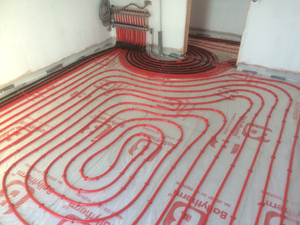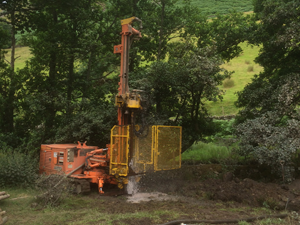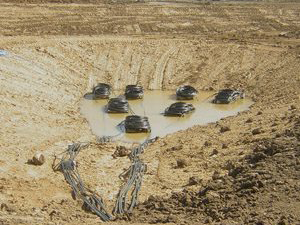GROUND SOURCE HEAT PUMPS
Heat pumps have been in existence since the early 1900’s in the form of other systems, but with using the same technology. Refrigerators and air conditioning systems use a similar technology to heat pumps but it was not until around the 1970’s when heat pumps were introduced into residential properties. Ground source heat pumps have been used in the USA and Northern Europe for many years and provide a very reliable and effective heating solution comparable to conventional fossil fuelled systems.
Although it has taken some time for heat pumps to be understood by homeowners, times are changing and in the UK heat pumps are now a proven technology in an ever growing market place. Heat pumps work by utilising the natural heat energy produced by the sun. This energy is absorbed into the earth’s surface which acts as a giant heat store. The ground loop array or ground collector, which is the buried pipe, absorbs this low temperature heat from the surrounding ground and transports this heat to the heat pump. The ground loop or heat collectors which carry a glycol/antifreeze mix can be installed using different methods. Ground source heat pumps can use various heat collectors such as pipe laid horizontally in the ground or vertically in a borehole. Heat can be obtained from rivers, streams, ponds, the sea or water wells – in theory wherever there is a medium of heat or a heat source, a heat pump can be utilised.

Types of Ground Loop Arrays/Collectors Available
Horizontal Collectors
Horizontal Collector for Ground Source Heat PumpPolyethylene pipe is buried in trenches or over a large, excavated area. Ground collector pipes can vary from 20mm, 32mm or 40mm, but in principle the idea is the same. The depth of the pipe needs only to be 1200mm or 4 feet, and occasionally sand may be required to act as a cushion around the pipe. Individual manufacturers recommend specific methods of loop installation but in general there are three main systems which are straight runs of collector pipe where trenches are excavated and pipe is run up and down a designated area until all of the required pipe is buried, a matting effect where a large area is excavated and a series of loops buried creating an underfloor pipework effect in the ground or slinkies which are pre-manufactured coils of pipe which are rolled out into varying lengths of trench. These can be installed vertically or horizontally and when installed resemble a spring which has been pulled apart.
Although the ground loop collector sounds simple, the sizing and design of the layout is crucial. Sufficient ground loop must be installed to keep up with the heat losses of the property, the design and size of the heat pump being installed and be spaced over a required land area so not to potentially ‘freeze the ground’ whilst maintaining the minimum flow rates calculated in the design stage.

Vertical Collectors
Drilling Rig Open Loop Vertical Drilling SectionIf there is an insufficient area available for the horizontal method then an alternative is to drill vertically. Drilling is not only a useful method when trying to obtain heat from the earth but boreholes are beneficial when using a heat pump in reverse for cooling in the summer months. There are two main drilling options being a closed loop system or an open loop system.

Drilled Closed Loop Systems
Boreholes can be drilled to different depths depending upon the size of heat pump required, and the geology of the land. They are approximately 150mm in diameter and are typically drilled to between 50m – 120 metres deep. A thermal loop is inserted down the borehole and the hole is grouted up with a thermally enhanced grout. The principle is the same as horizontal ground loops with a glycol mix being pumped around the loop to collect heat from the ground. Boreholes, however, are expensive to install and sometimes require more than one. Geological reports are crucial for both the driller and to determine conductivity.
Drilled Open Loop Systems
Drilled open loop systems are where boreholes are drilled in order to achieve a good supply of water from the ground. Water is pumped out and passed directly over the heat exchanger of the heat pump. Once the ‘heat’ has been passed over the heat exchanger this water is then re-injected down another borehole, back into the ground or into a local waterway.
Open loop systems are extremely efficient because the water temperature will normally be of a higher more constant temperature and in effect cut out the use of a heat exchanger. They do, however, require more detailed design and planning with approval from local authorities and the Environment Agency.
Pond Loops
Pond Loops for Ground Sourced Heat PumpsIf there is a sufficient pond or lake to use then pond mats (mats of pipe) can be submersed to enable heat to be extracted from the water. This is a closed loop system with a glycol mix again being pumped around the pipe which makes up the pond mats. Consideration has to be given to seasonal variation in water levels and generally not many ponds are suitable due to an insufficient area / volume of water.
Pond loops can be very efficient if designed and sized correctly; flowing water is more efficient because of the constant introduction of heat and the water or ‘heat source’ should never drop below around 5oC. Pond loop systems are also beneficial for cooling during the summer months when the heat pump is reversed.

